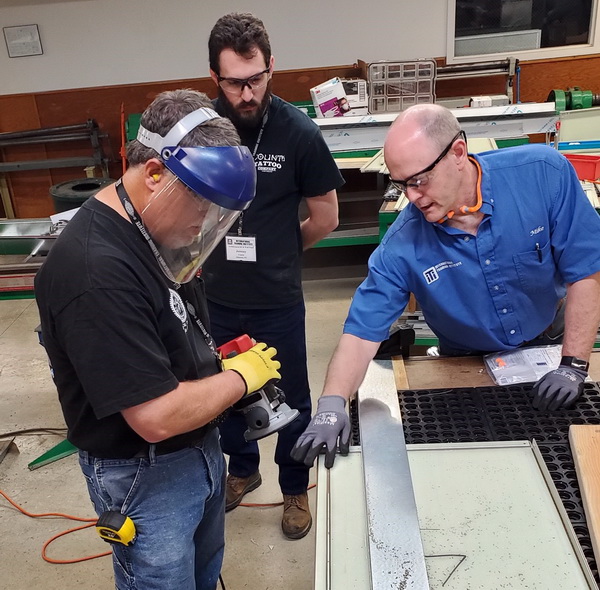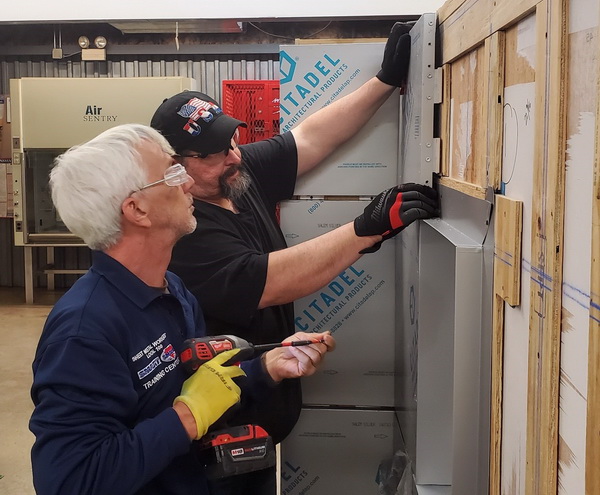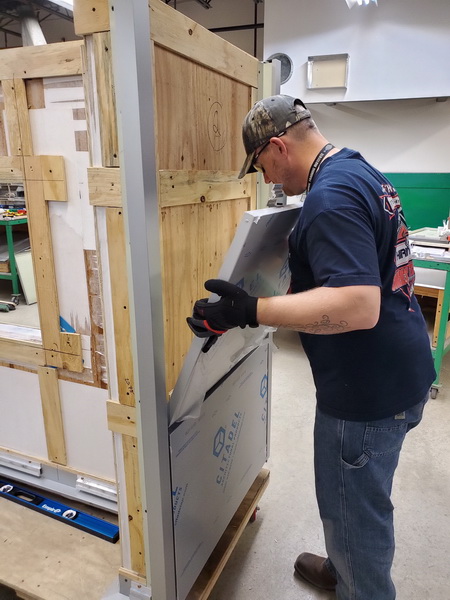
ITI Strike Force Training Philadelphia 2019.
As building envelope designs become more complex, so does installing their intricate wall paneling systems. Architects and design professionals are increasingly calling for the latest in-demand wall paneling systems and this is where the International Training Institute (iTi) comes in to lend quick support. Almost anytime and anywhere, the iTi can jump in with its Strike Force Training team to teach architectural sheet metal workers how to work with specific wall paneling systems.
Recently, when staff at Sheet Metal Workers Local 100 in Suitland, Maryland realized that an increasing number of construction projects were requiring specific building envelope and wall paneling systems, they contacted SMART's International Training Institute’s Strike Force Training program.
This quick-response training initiative offered by the International Training Institute has become a go-to resource for specialized training in exterior wall and roof panel cladding systems such as metal composite material (MCM) panel systems, metal roofing, foam insulated metal wall panel systems, single skin systems, and others.
Soon after Local 100 submitted their Strike Force Training request, plans to build a new concourse at Reagan National Airport were announced. SMACNA firm Kalkreuth Roofing and Sheet Metal out of Wheeling, West Virginia won the job and Local 100 knew they would be working on these specialized systems sooner than later. Strike Force has already taken action and will deliver tailored training this Fall of 2019. The training will focus on how to install Centria metal panels and architectural louvers, which have been called for in the airport project specifications. The new concourse is expected to be completed in 2021.

Installing a wall panel.
This nimble Strike Force training program has had a hand in many success stories like this. Almost mid-way through its third year, the program is delivering specialty training sessions at Joint Apprentice Training Centers (JATC) around the United States and Canada. Training sessions typically take three days and 12 instructors travel to JATCs to provide this type of hands-on specialty training. These product-specific courses typically concentrate on the “what, how and why” of complex wall panel system installation used on projects out for bid.
“Building enclosure designs are constantly changing due to technological innovation, code requirements and the modernization of installation means and methods,” said Dan McCallum, the iTi’s architectural specialist. “As architectural building designs become more intricate and more complex, so does the installation.”
According to McCallum, sometimes there is a new construction project coming to town, so SMACNA partners with a local union office to expand their workers’ knowledge base and enhance their skill sets to ensure better performance with specialty products. For example, Strike Force conducted training for Local 24 in Columbus, Ohio last year to get their members trained on a specialty wall panel installation at a new Facebook data center.
Strike Force plans the training sessions with contractors, local union business managers, and manufacturers to learn about the project and determine the course training material that is needed.
“It's not just a one-and-done service,” noted Jim Page, the iTi administrator. “We help the local unions develop a plan that brings the project into focus.”
The goals of such project-focused training include higher production quality, no overages on labor hours and job costs, and more accurate estimates.
Other training requests that don't have a specific project focus also include a greater emphasis on outreach to the architectural and design community.
“It's about marketing and branding ourselves,” McCallum remarked. Since the Strike Force courses are held at local JATCs, architects and design professionals from the area are invited to attend for free. These stakeholders also get to meet their potential SMART and SMACNA partners and tour the training facility.
One goal is to prevent architectural sheet metal jobs from going to carpenters and other trades. “We use the opportunity to introduce ourselves to the building design community,” McCallum added. “We encourage them and say, “please use us for everything you can (in your projects). It really does make a difference.”

Installing a Citadel Envelope 2000 Rainscreen Dry Joint MCM wall panel.
The Western Washington Sheet Metal Workers Local Union 66 is taking this outreach and marketing approach during a Strike Force training on June 4 to 6 in Seattle, Washington. The core of the program features metal wall panel installation training for Local 66 members. It includes a hands-on installation class with manufacturer certification for training in architectural horizontal foam panels, insulated composite back up panels and an aluminum plate rain screen system. Local architects and wall consultants may attend the training for free. It includes a presentation on maximizing envelope performance with IMP-integrated components.
McCallum also instructs the sessions. He has direct experience with architectural sheet metal and worked at the Warko Group in Reading, Pennsylvania, as vice-president of estimating and managing architectural sheet metal and HVAC projects.
The hands-on training content features best practices and techniques used for field layout and measuring of wall panel systems.
During the Seattle training, for the first time, Strike Force is including a construction technologist from a large power tool company to deliver a presentation directly to invited architects, engineers and signatory contractors on the technology used in construction including how augmented and virtual reality – along with 3D printing, robotics and drones – are changing how contractors design and build.